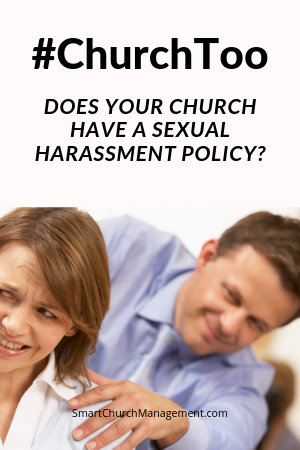Estimated reading time: 6 minutes
As church leaders, we strive to create healthy work environments that encourage and motivate employees.
However, experience has taught us that occasionally the behaviors of people don’t align with the biblical principles that we embrace.
Sometimes, these behaviors are intentional, but often, behaviors are unintentional – yet still concerning.
Sexual Harassment
It is difficult to turn on the news without reading about a new sexual harassment or assault allegation.
It is honestly shocking to read some of the stories of sexual harassment in the workplace and its impact on the victim – as well as the accused.
Ironically, the person accused often claims they did nothing wrong and were clueless as to how their actions impacted another person.
Joe Biden’s approach to invading the personal space of others is an example of how insensitive the accused can be.
Harassment in the Workplace Comes with a Cost
Sexual harassment in the workplace is not only a detriment to a healthy work environment, but it can turn into costly litigation.

Litigation is on the rise. The EEOC recovered nearly $70 million for the victims of sexual harassment through litigation and administration in FY 2018. This is up from $47.5 million in FY 2017.
Employees have the right to come to work without fear of someone harassing them – even in jest.
The #MeToo and now #ChurchToo Movement has brought this issue front and center, and organizations are now rethinking their culture, how they train their workers, and their tolerance for inappropriate behaviors.
The hidden costs of sexual harassment
Loss of Productivity
Let’s be real. If someone is being harassed at work, they are likely distracted and ultimately unmotivated.
Particularly if the person does not have the personality to push back or challenge inappropriate advances.
The employee will now be navigating the workplace in fear rather than focusing on getting the job done.
Increased Absences
An employee who is being harassed will try to escape by calling in sick and not coming to work.
A 2018 study found that approximately one in six employees who experienced sexual harassment took sick or annual leave following their harassment.
Legal Costs
Organizations that need to defend themselves against a sexual harassment claim will spend significant dollars on attorney fees and possibly a settlement with the person making the claim.
The hidden costs are a significant distraction the organization endures while going through the process. Churches want to focus on their mission – not deal with claims of harassment.
Employee Turnover
It is an undisputed fact that employees leave their jobs more because of their immediate supervisor than any other reason.
Employees who are harassed at work and feel like there is no escape often seek other employment. Unfortunately, these employees leave, and the organization never knows why – unless litigation is imitated.
But we are a church?
Let’s not be naive and think this kind of behavior doesn’t happen in a church setting- because it does.
5 Tips to Protect Your Church From #ChurchToo
1. Board Oversight
At the end of the day, a church board is responsible for the behaviors of those it oversees.
The board should make a public commitment to protecting employees, volunteers and members from any type of harassment – but particularly those of a sexual nature.
If an allegation is made, the board needs to move quickly to investigate, make every effort to protect the victim, and determine a resolution.
2. Heighten Awareness Of Sexual Harassment
Churches are committed to creating a work culture that is centered on biblical principles.
Be proactive and make employees aware that the church strives to provide a safe and healthy workplace. Let employees know that you take any type of harassment in the workplace seriously and want to be made aware if any issues arise.
Communicate expectations for employees to report and for management to take appropriate actions.
3. Write Policy For Sexual Harassment
Invest the time to create a harassment policy. This policy will guide the response on the rare occasion that an allegation is made.
Consider including some of the following in the policy:
Definition of harassment: How does the church define harassment? Be very specific, regardless of how difficult it is to describe those behaviors that cross the line.
Instructions for the employee’s response: Employees need to be direct and ask the accused to stop and to know that it is safe to report an accusation. But also an acknowledgment that some employees may be fearful of a confrontation.
Instructions for management’s response: Managers should know how to respond to an allegation of harassment and move quickly to get it resolved.
Instructions for a written report of the allegations: This includes creating a reporting document and process for an investigation.
Instructions for conducting an investigation: Where do you start, what questions do you ask and how to verify the information you learn.
Confidentiality: Allegations of harassment are by nature a private issue. Define how the organization will protect those who are impacted and only share information with those who have a need-to-know.
Consequences of policy violation: Enforcement of policy is critical to its effectiveness. In the same way, the response to an issue and the resulting consequences are equally important.
Policies are only as effective as the organization’s ability to make employees aware of the policy and its commitment to enforcing it. A policy without enforcement is what gets organizations in trouble. Make sure if you write it – commit to enforcing it!
4. Training
Incorporate all policies into your training and onboarding programs. Take the time to speak specifically about the organization’s commitment to maintaining a safe environment for all employees.
Do this by reviewing the harassment policy. Ensure employees know that management is there to support them, and if they encounter an uncomfortable interaction, say something.
5. Act Quickly On Allegations of Sexual Harassment
Case studies show that liability rests with the organization’s response to allegations. Those who ignore reported harassment will have more trouble defending themselves than those who act swiftly to correct the situation.
Use your policy to guide how investigations will be handled, communication with the victim, and resulting disciplinary action (if needed).
Avoid the mistake of ignoring an allegation. If someone says something, do something.
It is a sad day when churches have to write policies for harassment – but we do. Our first and most important responsibility is to keep those in our midst safe.
Take the time to define what harassment looks like for your organization, communicate, write policy, and follow up.
This is an important step you can take to safeguard your church from allegations of harassment or misconduct.
If you are a member, you can access a sample sexual harassment policy, a sexual harassment reporting form, and an employee conduct policy. You can access them here.
If you are not a member but would like to become one and access our library of forms, documents, and job descriptions, we would love to have you! You can access the library here!



